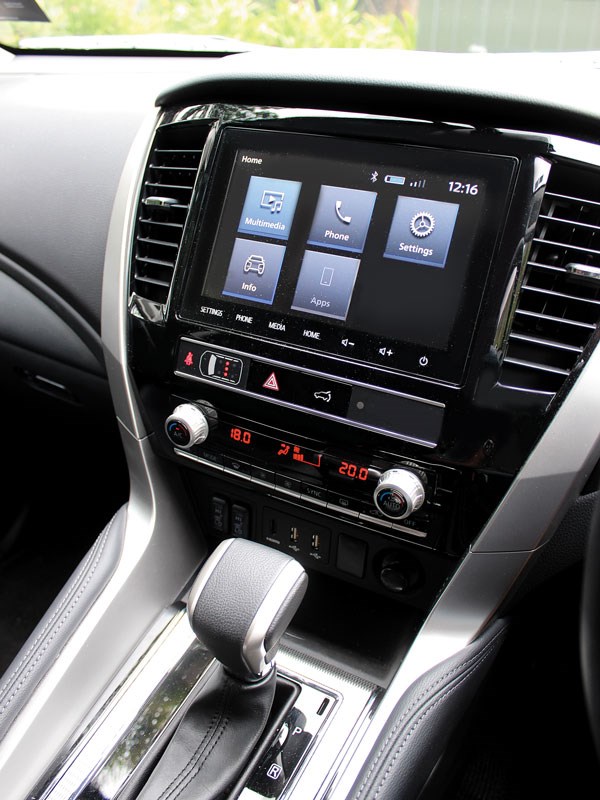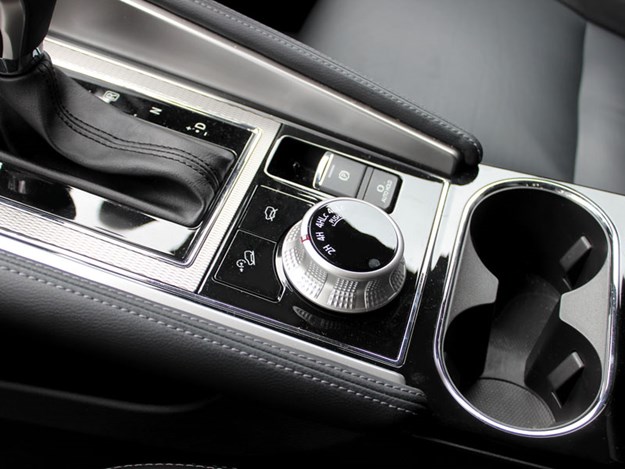Review: Mitsubishi Pajero Sport
Mitsubishi’s Pajero Sport builds on the familiar, with all-new design attributes and a reworked interior, but room for seven underpinned with the Japanese manufacturer’s dependable 4WD mechanicals
 |
|
A new front grille is the most obvious feature of the recently made-over Pajero Sport
|
Mitsubishi’s 2019 design and tech makeover of the Triton ute is probably one of the most successful spruce-ups in recent times. Remember that when it originally launched over a decade ago, the Triton was lambasted for its ‘soft’ curvy design, especially around the rear of the wellside tray.
The Japanese manufacturer tidied things up significantly with a generation-two overhaul. In the meantime, the company’s solid warranty offering saw many in the Kiwi market move towards their local Mitsubishi dealer.
 |
|
A large touchscreen lets the driver and front seat passenger control infotainment settings
|
While Ford and Toyota battled it out at the top of the table (with the Ranger and Hilux respectively), Mitsubishi quietly got on with establishing itself as a podium player. The Triton got a new face, new interior features, and new infotainment and safety technology last year, and now the Pajero Sport has followed suit. More aggression up front, more comfort inside, and more driver assistance when you’re on the move.
Which Pajero?
Firstly, if you’ve not caught up with the carmaker’s model rationale of late, don’t be picturing the boxy Pajero SUV of old. Amazingly, that was until very recently still available on the New Zealand market, but a mix of zero R&D input from the factory and ever-evolving tougher crash test regime criteria around the world meant that it simply wasn’t measuring up in terms of a safe vehicle to drive anymore.
Rather than completely overhaul it from the ground up as Land Rover has done with the Defender, Mitsubishi chose to park it completely. Well, no – not quite completely. Not the nameplate anyway. The Pajero Sport doesn’t really bear any resemblance to the big square Pajero (which existed in several iterations of slab-sided metal for a remarkable 37 years all up).
Like its direct descendent, the Challenger, you need to think of the Pajero Sport, instead, as the SUV version of the aforementioned Triton. Yep, it’s a ute with a boot. To that effect, it also drives more like a ute than an SUV, as it still features a traditional ladder chassis set-up underneath.
If you want true suburban smoothness and a lightness of touch to the steering, the smaller Outlander SUV is your best bet. But if you’re traversing rural roads with regularity – and might need your family vehicle to complete occasional extra off-road duties beyond the house paddock – then the Pajero Sport can offer up a decent mix of town and country suitability.
Nose job
 |
|
The tall nature of the Pajero Sport is accentuated by long taillight clusters
|
Anecdotally over the last few years, I’ve come to the realisation that the Pajero Sport boasts what polite society might call ‘polarising’ looks. The large chrome strips up front, the narrow glass area when viewing the SUV from the side, and the overall high-riding look – which the long taillights seem to accentuate – aren’t for everybody.
 |
|
Revisions to the exterior design give a more masculine look
|
/>Much like with the Triton truck, the latest generation updates to the Pajero Sport are designed to give it a more masculine look. The grille has been made more square and rugged, which serves to project a wider overall stance for the SUV.
.jpg) |
|
New corner-light clusters help give the SUV a wider-looking stance
|
New LED headlights, corner combination light clusters and a redesigned lower valance are augmented with new LED taillamps and a rear bumper design at the rear. The 18-inch alloy wheels have also been spruced up (now featuring a two-tone spoke design) and Mitsubishi include Toyo all-road tyres as standard on the model
 |
|
Revisions to the exterior design give a more masculine look
|
It’s worth noting that New Zealand receives just one grade of Pajero Sport, the VRX, which is essentially the manufacturer’s ‘bells and whistles included’ top-shelf offering.
Space station
 |
|
Integrated side-steps help passengers get in and out of the SUV
|
There are plenty of new elements within the Pajero Sport’s cabin, and they’re not all cosmetic. Mitsubishi has managed to eke out more lateral space for the driver and front-seat passenger by designing a narrower centre console and internal door skins.
Despite the centre console being narrower, there are more cubbies and pockets for storing mobile phones and other items within it. Rubberised grip surfaces will stop things sliding around in the various trays and storage pockets when you’re on the back roads too.
A bigger touchscreen for the stereo (which now includes Apple CarPlay and Android Auto compatibility) dominates the middle of the dashboard, while a revised steering wheel with all the usual modern convenience buttons festooned upon it is also a feature of the new vehicle.
There are also new controls for the heating and ventilation system, but don’t worry: Mitsubishi hasn’t gone the full touchscreen approach here. Analogue dials remain, which are much easier to set when you’re on the move.
 |
|
The new LCD instrument cluster debuts in the Pajero Sport and will be rolled out across future Mitsubishi models
|
The Pajero Sport also debuts a new instrument cluster for the brand, which will be rolled out in other models in years to come. It features an eight-inch LCD combination screen which gives the driver all manner of vehicle information using configurable display options.
 |
|
Switching between two- and four-wheel-drive is easy with the rotary controller
|
Another new feature for the manufacturer is the Mitsubishi Remote System controller, which is an app available for both Apple and Android devices that allows the driver to operate the electric tailgate remotely, receive notifications if they’ve left the vehicle’s lights on or failed to lock it, among other information.
The app also features a ‘Car Finder’ setting which will turn the Pajero Sport’s lights on for 30-second bursts: handy when you’re trying to locate it after that late-night shopping expedition.
Add some new safety specification to the offering – such as Rear-Cross Traffic Alert, which will sound a warning alerting the driver to vehicles approaching from the left or right when pulling out of a parking spot, and Blind Spot Monitoring – and it all adds up to a well-fettled seven-seat SUV for the $60k (give or take) sticker price.
Car, go
As also featured in the Triton ute range, Mitsubishi’s 2.4-litre MIVEC turbo diesel performs duty here. It offers up decent amounts of power and torque: the latter 437Nm of twist coming in handy when utilising the SUV’s 3100kg braked tow rating (or 750kg unbraked).
Combined with the sure-footed Super Select II 4WD system – which allows the driver to swap from front- to four-wheel-drive while on the move – the Pajero Sport feels solidly planted on the move, and with plenty of power in reserve.
Whether you want a ute or an SUV based on a ute will come down to personal preference. While the idea of a double cab ute appeals to many, without a canopy fitted there are definitely compromises to be dealt with in terms of cargo capacity and ease-of-use.
An SUV allows you to store plenty of stuff out of the elements, although traditional use as something which can have mucky boots, work gear and supplies chucked into the back of it might not appeal to everyone in the family.
 |
|
Seven seats add to the SUV’s practicality as a family wagon
|
And there’s very little in it in terms of millimetres of space: 1575mm length in the Pajero Sport, 1520mm in the Triton. Similarly, a Triton ute will only give you five seats versus the extra 50:50 split row in the Pajero Sport, taking its passenger capacity to seven. But evaluating just how often you might need seven seats could reveal this feature to be relatively redundant for the most part.
Verdict
Utes will certainly remain the ‘go to’ method of transport in the rural sector for the foreseeable future. But the Mitsubishi Pajero Sport delivers an admirable blend of rugged underpinnings worthy of the ‘Pajero’ nameplate, mixed with sophisticated styling and a commendable feature set of comfort, convenience and safety spec for the price.
Mitsubishi Pajero Sport specifications
| Engine | 2.4-litre MIVEC Turbo Diesel |
| Power | 135kW |
| Torque | 437Nm |
| Transmission | 8-speed automatic |
|
4WD system |
Super Select II 4WD with centre differential and high/low ratio |
| Ground clearance |
218mm |
| Wading depth | 700mm |
| Cargo | 805L (third row seats folded) |
| Tow rating | 3100kg (braked) |
| Fuel economy | 8L/100km |
| C02 emissions | 208g/km CO2 |
Find farm machinery for sale in NZ
Keep up to date in the industry by signing up to Farm Trader's free newsletter or liking us on Facebook


.jpg)
.jpeg)

.jpg)
.jpeg)
.jpg)
.jpeg)
.jpeg)

.jpg)
.jpg)
.jpg)

.jpg)

